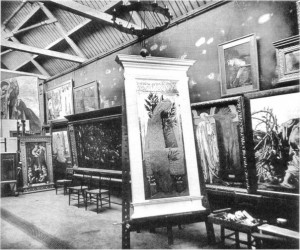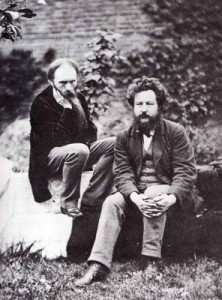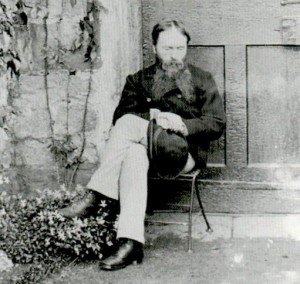Unknown Edward Burne-Jone

Burne-Jones’s Studio ‘I mean by a picture, a beautiful romantic dream of something that never was, never will be, in a light better than any light that ever shone, in a land no one can define or remember — only desire.”

In the garden of Burne-Jones' home (Grange, Fulham) in 1874 Sir Edward Burne-Jones’ home –The Grange“Nothing (with one small but important exception) remains of The Grange, where the Burne·Jones family lived for more than thirty years. It was in North End, Fulham, and consisted, from the eighteenth century on, of two red brick houses, standing back a little from the road, with iron gates and a short flagged path. Samuel Richardson had lived there from 1738 to 1754, (when his rent was put up to £40 p.a.), but there is no evidence that either Burne-Jones or Morris took any interest in Richardson. I’m writing not about the architectural history of the house or even about the pictures that were painted there, but from the point of view of a biographer. The Burne-Joneses went there in 1867, eleven years before Morris discovered Kelmscott House, but why did they go there at all? Certainly, they had to move. After the death of their second baby, Christopher, they went to 41 Kensington Square, where Margaret was born. But in 1867, when they came back from their summer holiday in Oxford with the Morrises, they found that their landlord had sold the lease and they had to be out by Christmas. Still, there were always plenty of houses to let in London. Why The Grange? North End contained two brewers, a horse-dealer, and a private asylum for ladies. This in itself shows how remote the place was, since (as readers of The Woman in White will remember) private asylums had to be as far as possible from any form of transport, and although the Thames Junction Railway ran through the fields below The Grange, trains didn’t stop there. Milk was still delivered in pails and there were briar roses in the lanes (but Burne-Jones was never a countryman anyway – the country, he complained, was so noisy). The north house, which was the one they chose of the two, had the advantage of a good north light and an indoor studio, but even with two children it was too big for them, and the rates were high in Fulham. They had in fact to share it at first with an old Birmingham friend, Wilfred Heeley, and his wife, who were waiting to go out to India, or they could never have managed the rent at all. The Grange, then, had almost nothing to recommend it to Georgie except inaccessibility. The directions were said to be ‘Go down the Cromwell Road till your cabhorse drops dead, and then ask someone.’ But, as it turned out almost immediately, it was not inaccessible enough.” 
Edward Burne-Jones … Source: ‘Life at the Grange’ by Penelope Fitzgerald |


This Post Has 0 Comments